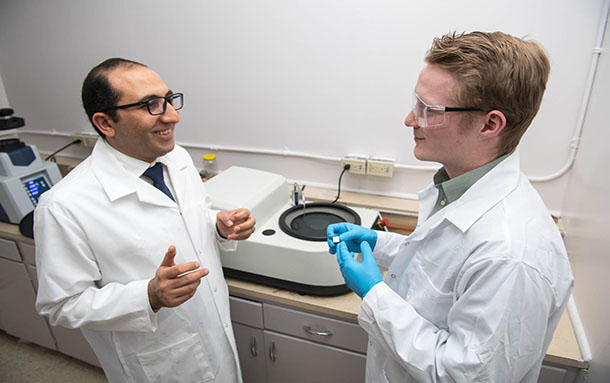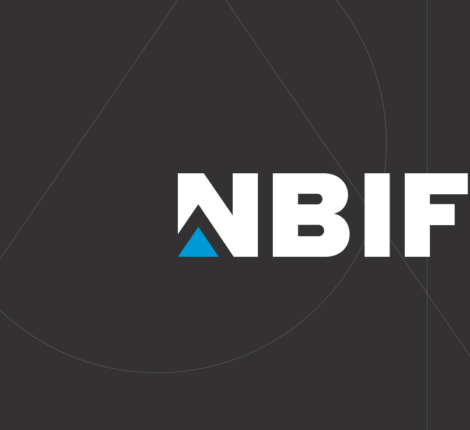- May 15, 2019
- Applied Research
- Comments : 0
Defining and Designing the Future of 3D Printing with Dr. Mohsen Mohammadi
One of the core pieces of the NBIF mission is supporting innovative research being done by
researchers around New Brunswick. These research projects show us the potential of new and exciting technologies; allow us to imagine new uses for existing procedures and materials; inspire commercial products that make our lives easier and more fulfilling; and teach us incredible things about the world in which we live.
We’re dedicating a series of posts over the next few months to researchers that we think everyone in this province should be familiar with.
Most of us have probably heard of 3D printing.
Some of us likely even know that it involves researchers and technicians using computer systems to turn digital models or computer-aided design (CAD) files into tangible objects that we can hold in our hands. For the first few decades of 3D printing’s existence, these objects were made mostly from plastic and used as simple prototypes in manufacturing and scientific environments.
But what if instead of only being able to print in plastic, you could print in metal too? All of a sudden, usable prototypes could be developed and tested almost instantly, instead of awaiting long fabrication processes. Parts could be made out of metal alloys that are difficult to mill and fabricate. Closet entrepreneurs with a compelling idea could test their designs without emptying out their wallets.
3D printing, also known more broadly as additive manufacturing, is what Dr. Mohsen Mohammadi and his team of researchers work on every day. An associate professor of Mechanical Engineering at UNB and the Director of the Marine Additive Manufacturing Centre of Excellence (MAMCE) in Fredericton, Dr. Mohammadi’s research has already led to huge companies like Lockheed Martin Canada and Irving Shipbuilding Inc. knocking down the door to his lab.
“The main thing that we’re working on is the question of how we can 3D print more metals,” Dr. Mohammadi explains. “There are thousands of alloys out there, and only about thirty to fifty are currently printable. But the great thing about working at MAMCE is it’s not just about the alloy ‘recipes’ – we can actually manufacture the parts ourselves too.”
3D printing and additive manufacturing have exploded in popularity since Dr. Mohammadi’s days as a PhD candidate at the University of Western Ontario and his subsequent post-doctoral fellowship at the University of Waterloo. All of a sudden, everyone wants a piece of this bold new technology. Since MAMCE opened up in 2016 as a partnership between UNB, NBCC, CCNB and industrial partners like Lockheed and Irving, there haven’t been too many slow days at the office.
“Nobody believed in metal 3D printing in 2010,” Dr. Mohammadi recalls. “No one thought it was feasible for the supply chain, or that we would be able to reliably produce duplicates of alloys like stainless steel, titanium or aluminum. 3D printing is not like pushing a button – you have to ‘think’ like a 3D printer and design support structures and geometries, and people didn’t always want to listen to that.”
They’re certainly listening now. Dr. Mohammadi says that New Brunswick is rapidly becoming an international player in additive manufacturing, and that more and more companies are recognizing that MAMCE and UNB are names to watch out for in this field. So far the Centre of Excellence has received funding from the aforementioned Lockheed Martin and Irving, as well as federal funding from ACOA and $250,000 from the NBIF in 2018. Dr. Mohammadi is particularly appreciative of the NBIF’s contributions, which have also numbered among them a $25,000 emerging projects grant for the advanced study of 3D printing in 2017.
“Funding from the NBIF has allowed us to redefine space, hire personnel and purchase equipment, and in this industry it’s very important to have the right equipment. But it’s also important to have the right people to operate those machines, and because of programs like the Research Assistantship Initiative, the centre can really be a hub for training our future workforce,” he says.
“However, to my mind, the NBIF’s most important contribution is that they were the first organization to believe in what we could do. Before the federal agencies, before our industrial and corporate partners, NBIF was in our corner.” In fact, NBIF actually initially recruited Dr. Mohammadi to New Brunswick in 2015 by providing him with a $75,000 start-up grant that enabled him to set up his lab at UNB.
The future is looking bright, with several projects on the horizon designed to move research forward in this still brand-new field of study. Dr. Mohammadi is optimistic, but also notes that all of the work happening at MAMCE, all of the investigations of how alloys react to corrosion and harsh temperatures, all of the designs of new micro-lattices, is just the very beginning.
“This is a small tree that we just planted a few years ago,” he says. “Innovation is not a one-time investment. It needs to be nurtured to bear fruit.” There’s no doubt in our minds that Dr. Mohsen Mohammadi and his colleagues at the Marine Additive Manufacturing Centre of Excellence will be up to their ears in (3D printed!) fruit before long.


